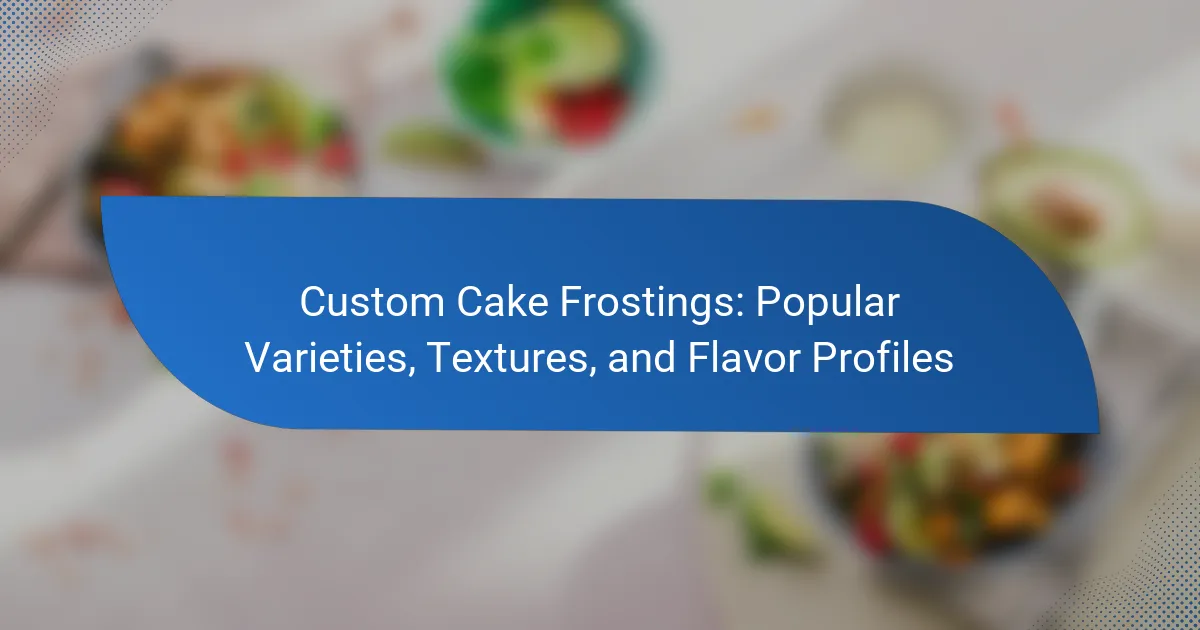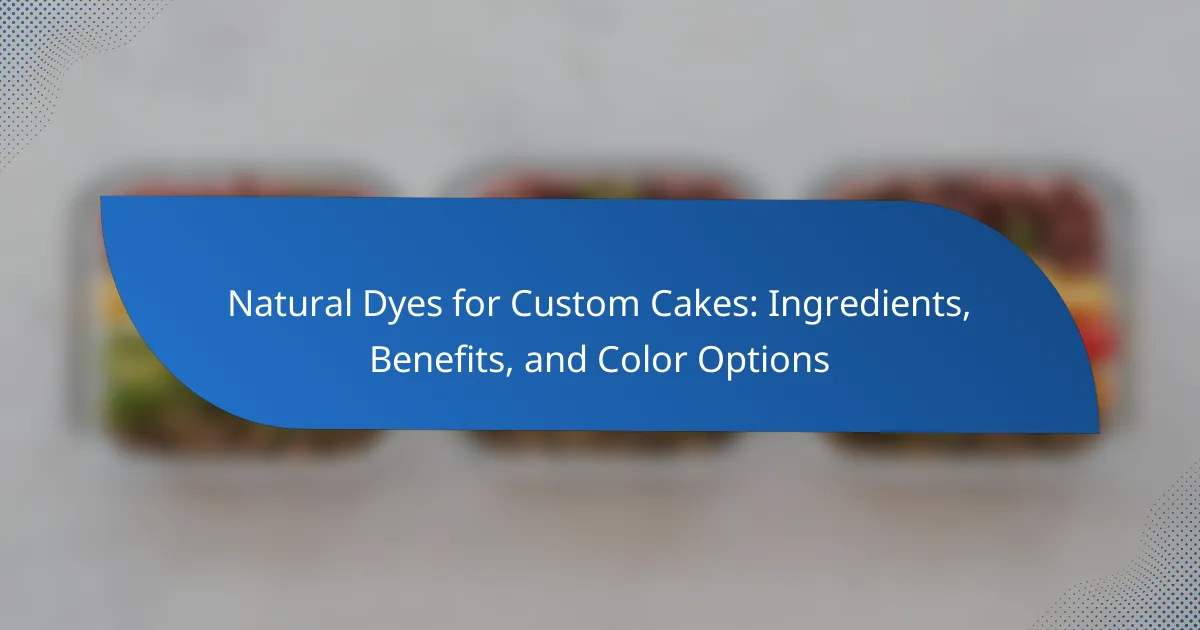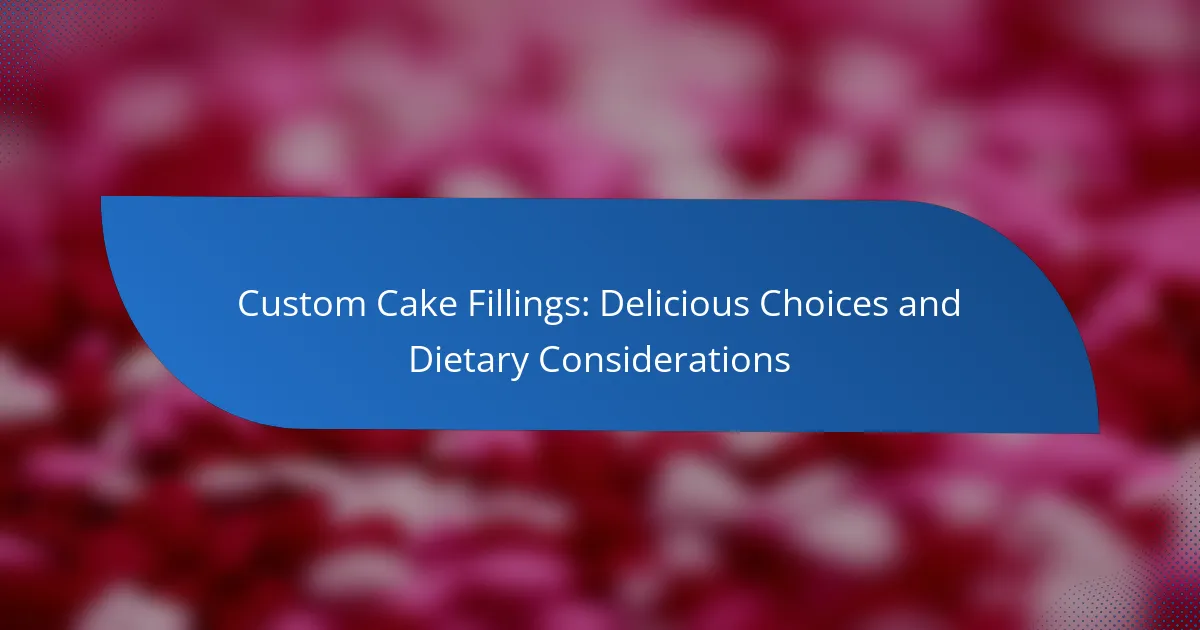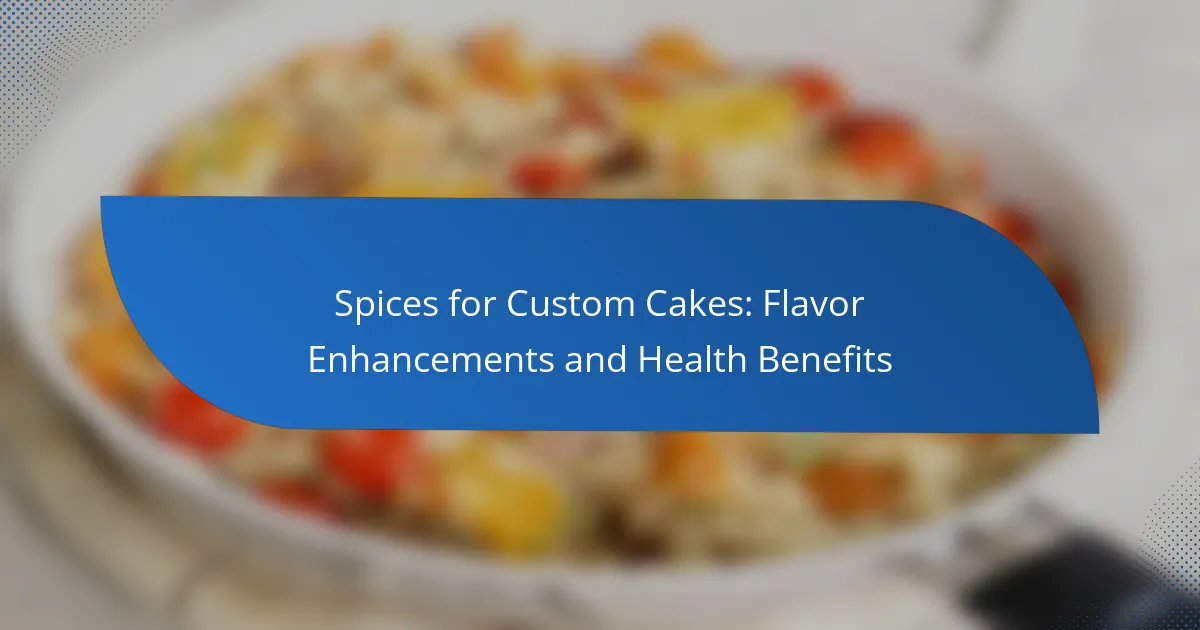Essential custom cake flavorings are unique ingredients that enhance the taste of cakes, including extracts, essences, and natural components like spices and herbs. Common flavorings such as vanilla, almond, and citrus can be tailored to individual preferences, transforming simple cakes into gourmet experiences. Best practices for pairing flavorings with cake types involve understanding flavor profiles, balancing sweetness, and considering seasonal ingredients. Selecting the right flavorings requires attention to the cake’s theme, texture, and audience preferences, while experimenting with combinations ensures memorable desserts. This article provides insights into essential flavorings and effective pairing strategies for creating delicious and visually appealing cakes.

What are Essential Custom Cake Flavorings?
Essential custom cake flavorings are unique ingredients used to enhance the taste of cakes. These flavorings include extracts, essences, and natural ingredients. Common examples are vanilla, almond, and citrus extracts. They provide distinct flavors that can be tailored to individual preferences. Additionally, custom flavorings can include spices, herbs, and even savory elements. The use of these flavorings allows for creativity in cake design. They can transform a simple cake into a gourmet experience. The right combination of flavorings can create memorable desserts.
How do custom cake flavorings enhance the overall cake experience?
Custom cake flavorings significantly enhance the overall cake experience by providing unique and personalized taste profiles. These flavorings allow bakers to create cakes that reflect individual preferences and themes. For example, flavors like lavender or matcha can transform a standard vanilla cake into a gourmet experience. Custom flavorings also enable the combination of complementary tastes, such as pairing chocolate with raspberry or lemon with basil. This versatility can elevate the cake’s appeal for various occasions, from weddings to birthdays. Research indicates that flavor variety plays a crucial role in consumer satisfaction, with unique flavor combinations often leading to higher enjoyment levels. By tailoring flavors to specific events, custom cake flavorings ensure that each cake is memorable and distinct.
What makes a flavoring essential for custom cakes?
Flavoring is essential for custom cakes because it defines the overall taste and character of the cake. A well-chosen flavor can enhance the cake’s appeal and create a memorable experience. Flavoring contributes to the cake’s uniqueness, allowing for personalization to suit individual preferences. It also plays a role in balancing sweetness and texture, making the cake more enjoyable. The right flavor can evoke emotions and memories, further enriching the eating experience. Additionally, flavoring can complement other ingredients, such as fillings and frostings, creating a harmonious dessert. The use of various flavorings can cater to diverse dietary needs and trends, ensuring inclusivity. Overall, flavoring is a crucial component that elevates custom cakes from ordinary to extraordinary.
How do flavorings impact the texture and moistness of a cake?
Flavorings can significantly impact the texture and moistness of a cake. They often contain moisture, which can enhance the overall hydration of the batter. For instance, liquid flavorings like vanilla extract or fruit purees contribute additional liquid to the mix. This can lead to a softer crumb and increased moistness.
Moreover, flavorings like sour cream or yogurt not only add taste but also improve the cake’s density and tenderness. The fats present in certain flavorings, such as butter or cream, can create a richer texture. Additionally, some flavorings can interact with other ingredients, like baking soda or baking powder, affecting the cake’s rise and final texture.
Research indicates that incorporating flavorings can change the cake’s structure, making it lighter or denser depending on the type used. For example, a study published in the “Journal of Food Science” found that cakes made with fruit purees had improved moisture retention compared to those made with dry flavorings. This highlights the importance of choosing the right flavoring for achieving desired textural qualities in cake baking.
What types of flavorings are available for custom cakes?
Vanilla, chocolate, and almond are common flavorings for custom cakes. Other popular options include lemon, red velvet, and carrot. Unique flavorings can also be used, such as lavender, matcha, and coconut. Seasonal flavors like pumpkin spice and peppermint are popular during specific times of the year. Fruit-based flavorings, such as raspberry, strawberry, and orange, add natural sweetness. Additionally, spice flavors like cinnamon and nutmeg can enhance the cake’s profile. Custom cakes often allow for combinations of these flavors to create unique taste experiences. The variety of flavorings available caters to diverse preferences and occasions.
What are the most popular flavoring options for cakes?
The most popular flavoring options for cakes include vanilla, chocolate, and lemon. Vanilla is often considered the classic flavor and is widely used in various cake recipes. Chocolate provides a rich and indulgent taste, making it a favorite for many. Lemon adds a refreshing and tangy flavor, often used in lighter cakes. Other popular options include red velvet, almond, and coconut. Red velvet offers a unique flavor profile with a hint of cocoa and a vibrant color. Almond flavoring gives a distinct nutty taste, while coconut provides a tropical twist. These flavors are commonly chosen for their versatility and appeal in cake baking.
How do natural and artificial flavorings differ in custom cakes?
Natural flavorings come from real food sources, while artificial flavorings are synthesized chemicals. Natural flavorings often provide a more authentic taste and aroma. They can enhance a cake’s flavor profile significantly. For example, vanilla extract is derived from vanilla beans. In contrast, artificial flavorings like vanillin mimic the taste but lack depth. Natural flavorings may also contain additional nutrients. Artificial flavorings are typically more cost-effective and have a longer shelf life. However, some consumers prefer natural options for health reasons. This preference is supported by a growing trend toward organic and clean-label products in the baking industry.
How can unique flavor combinations elevate a cake?
Unique flavor combinations can elevate a cake by enhancing its taste and creating memorable experiences. These combinations introduce contrasting and complementary flavors, which stimulate the palate. For example, pairing citrus with herbs can add freshness and complexity. Additionally, combining sweet and savory elements can create a surprising balance. Flavor pairings like chocolate and chili or vanilla and lavender can evoke unique sensory responses. Studies show that diverse flavor profiles can increase customer satisfaction. Ultimately, unique combinations can transform a standard cake into an extraordinary dessert.
What are some innovative flavor pairings to consider?
Innovative flavor pairings to consider include lavender and lemon, which create a refreshing, aromatic experience. Another pairing is chocolate and chili, offering a rich flavor with a spicy kick. Matcha and white chocolate provide a unique balance of earthy and sweet notes. Additionally, rosemary and honey combine herbal and sweet elements for a sophisticated taste. Finally, basil and strawberry offer a fresh, fruity contrast that enhances both flavors. These pairings can elevate custom cakes, making them memorable and distinct.
How do cultural influences shape unique cake flavorings?
Cultural influences shape unique cake flavorings by incorporating traditional ingredients and methods from various regions. For instance, Asian cultures often use matcha or red bean in their cakes. These flavors reflect local agricultural practices and preferences. In contrast, Latin American cakes may feature flavors like dulce de leche or coconut, showcasing the region’s rich culinary heritage. Historical trade routes also played a role in flavor development. Spices introduced from different cultures have influenced cake recipes globally. This blending of flavors results in diverse cake options that celebrate cultural identities.
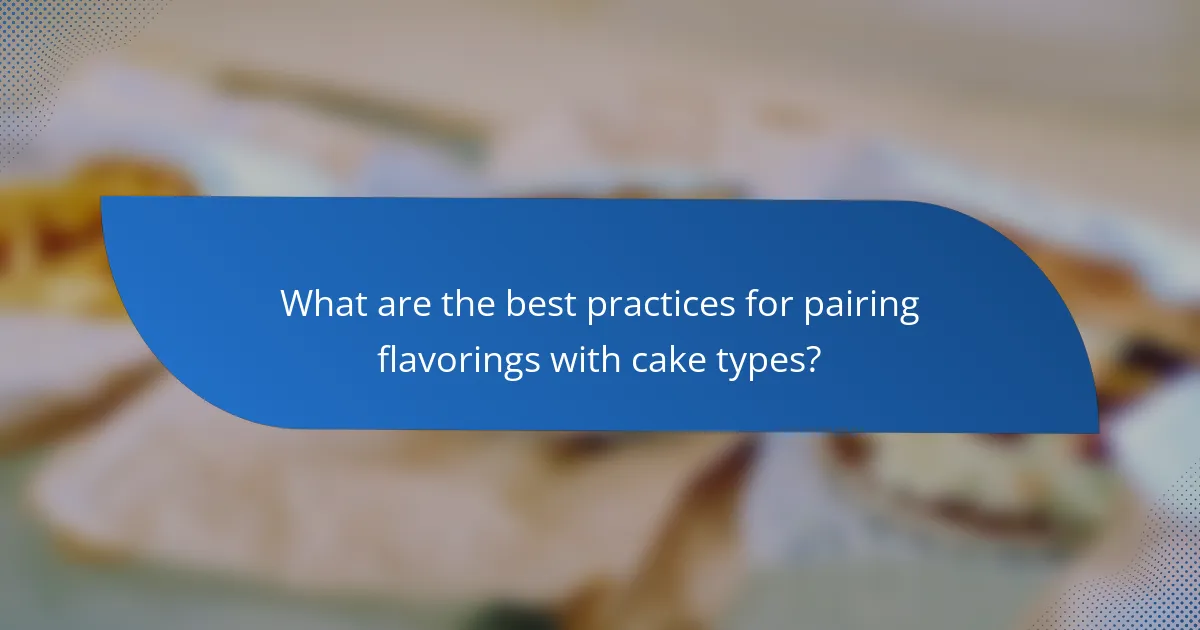
What are the best practices for pairing flavorings with cake types?
The best practices for pairing flavorings with cake types include understanding the flavor profile of each cake. For example, vanilla cakes pair well with fruity flavorings like lemon or raspberry. Chocolate cakes complement richer flavors such as espresso or caramel. Spice cakes often enhance flavors like cinnamon or nutmeg.
Additionally, consider the texture of the cake. Light cakes benefit from delicate flavors like almond or lavender. Dense cakes can handle bolder flavors such as bourbon or dark chocolate.
Balance sweetness levels in flavorings with the cake type. For instance, a sweet buttercream frosting works well on a mildly sweet cake. Sour flavorings can counterbalance overly sweet cakes effectively.
Finally, consider seasonal ingredients for pairing. Fresh berries in summer or pumpkin spice in fall can elevate the cake experience. These practices ensure harmonious flavor combinations that enhance the overall dessert.
How do different cake bases affect flavor pairing?
Different cake bases significantly influence flavor pairing. Each base has distinct characteristics that complement or contrast with various flavors. For example, vanilla cake is versatile and pairs well with fruity or creamy fillings. Chocolate cake, on the other hand, enhances rich flavors like caramel or coffee. Red velvet cake, with its subtle cocoa flavor, works well with cream cheese or berry fillings. Spice cakes, such as ginger or cinnamon, complement flavors like citrus or nuts. Yellow cake’s buttery flavor pairs nicely with chocolate or fruit fillings. Each cake base’s texture and sweetness also play a role in how flavors interact, creating a harmonious balance in desserts.
What are the ideal flavorings for chocolate cakes?
The ideal flavorings for chocolate cakes include vanilla, coffee, and almond. Vanilla enhances the chocolate flavor, creating a rich and balanced taste. Coffee intensifies the chocolate, adding depth and complexity. Almond provides a unique nutty note that complements the sweetness of chocolate. Other flavorings like mint, orange, and raspberry can also pair well with chocolate. Mint adds a refreshing twist, while orange brings a citrusy brightness. Raspberry introduces a tart contrast that enhances the overall flavor profile. These flavorings are commonly used in various chocolate cake recipes to elevate the dessert experience.
Which flavorings complement vanilla cakes best?
Almond, lemon, and coconut flavorings complement vanilla cakes best. Almond extract adds a nutty sweetness that enhances vanilla’s richness. Lemon zest brings a bright, citrusy note, balancing the cake’s sweetness. Coconut provides a tropical flavor that pairs well with vanilla’s creaminess. These flavorings create a harmonious blend, elevating the overall taste profile.
What role do seasonings and spices play in flavoring cakes?
Seasonings and spices enhance the flavor profile of cakes significantly. They add depth and complexity to the overall taste. Common spices like cinnamon and nutmeg provide warmth and sweetness. Other seasonings, such as vanilla extract, contribute aromatic qualities. The right combination can elevate a simple cake to a gourmet experience. For instance, using cardamom can impart a unique floral note. Additionally, spices often work synergistically, creating a balanced flavor. Historical baking practices show that spices have been used for centuries to enrich desserts.
How can spices enhance traditional cake flavors?
Spices can enhance traditional cake flavors by adding depth and complexity. Common spices like cinnamon, nutmeg, and ginger elevate sweetness and provide warmth. For example, cinnamon complements apple cakes and adds a comforting aroma. Nutmeg enhances the richness of pumpkin cakes, creating a classic fall flavor. Ginger adds a zesty kick to spice cakes, balancing sweetness with heat. Historical recipes often incorporate spices to enhance flavor profiles, demonstrating their importance in baking. The use of spices can transform simple cakes into gourmet desserts, making them more appealing and flavorful.
What are some seasonal flavor inspirations for cakes?
Seasonal flavor inspirations for cakes include pumpkin spice for fall, featuring cinnamon and nutmeg. Winter flavors often incorporate peppermint or gingerbread spices. Spring brings fresh fruit flavors like lemon and strawberry. Summer cakes can highlight tropical flavors such as coconut and pineapple. Each season offers unique ingredients that enhance cake recipes. For example, pumpkin is widely used in autumn desserts. Peppermint is a classic winter flavor, often paired with chocolate. Fresh strawberries are popular in spring cakes, while coconut adds a refreshing touch in summer. These seasonal flavors resonate with holiday themes and celebrations.

What tips can help in selecting and using custom cake flavorings?
Select custom cake flavorings by considering the cake’s theme and audience preferences. Choose flavors that complement the cake’s texture and structure. Experiment with extracts, purees, and spices to create unique combinations. Balance strong flavors with milder ones to avoid overpowering the cake. Use fresh ingredients for the best taste and aroma. Test flavorings in small batches before scaling up. Keep flavor intensity in mind; some flavorings are more potent than others. Document your flavor combinations for future reference and consistency.
How can bakers experiment with flavorings effectively?
Bakers can effectively experiment with flavorings by starting with small quantities. This allows them to gauge the intensity of each flavor. They should document their ratios and results for future reference. Using complementary flavor pairings can enhance the overall taste. For instance, chocolate pairs well with coffee and vanilla. Bakers can also try infusing liquids like milk or cream with herbs or spices. This method extracts deeper flavors. Taste testing with a small group can provide valuable feedback. Adjustments can be made based on this feedback to refine the recipe.
What are the common mistakes to avoid when flavoring cakes?
Common mistakes to avoid when flavoring cakes include using too much extract or flavoring. This can overpower the cake’s taste. Another mistake is not balancing flavors properly. For instance, combining sweet and savory elements without consideration can lead to an unappealing result. Not considering the cake’s base flavor is also crucial. A chocolate cake may not pair well with certain fruit flavors. Additionally, neglecting to taste the batter before baking can result in an unbalanced flavor profile. Lastly, using low-quality flavorings can diminish the overall quality of the cake. High-quality ingredients enhance flavor and texture.
How can bakers balance flavors to achieve the desired taste?
Bakers can balance flavors by understanding the key components of taste. These components include sweetness, acidity, bitterness, and saltiness. For instance, adding a pinch of salt can enhance sweetness in desserts. Conversely, incorporating acidic ingredients like lemon juice can brighten flavors and reduce cloying sweetness.
Bakers often use flavor pairings to achieve harmony. Classic combinations, such as chocolate and coffee, work well because they complement each other. Additionally, using herbs and spices can add depth to flavors, like pairing basil with strawberries.
Experimentation is essential for bakers. Tasting during the mixing process allows for adjustments before finalizing the recipe. This iterative approach helps achieve the desired taste balance.
Research indicates that the balance of flavors directly influences consumer satisfaction. A study published in the Journal of Culinary Science & Technology confirms that well-balanced flavors lead to higher preference ratings among tasters.
What resources are available for further exploration of custom cake flavorings?
Books on baking and cake design provide extensive information on custom cake flavorings. “The Cake Bible” by Rose Levy Beranbaum offers detailed flavor profiles. Online platforms like YouTube host tutorials on flavor combinations and techniques. Websites such as AllRecipes and Food Network feature user-generated recipes with innovative flavor ideas. Specialty baking blogs often explore unique flavor pairings. Additionally, forums like Reddit’s baking community allow for shared experiences and tips. Culinary schools and workshops offer hands-on learning about flavor development. These resources collectively enhance understanding and creativity in custom cake flavorings.
Where can bakers find inspiration for unique flavor combinations?
Bakers can find inspiration for unique flavor combinations in various sources. Culinary blogs and recipe websites often showcase innovative pairings. Baker communities on social media platforms share creative ideas and experiences. Flavor pairing charts provide insights into complementary tastes. Cookbooks focused on flavor profiles offer structured guidance. Seasonal ingredients inspire unique combinations based on availability. Local markets introduce bakers to regional flavors. Experimentation with herbs and spices can lead to unexpected discoveries.
What are the best books or websites for learning about cake flavorings?
The best books for learning about cake flavorings include “The Cake Bible” by Rose Levy Beranbaum and “Flavor Flours” by Alice Medrich. Websites such as King Arthur Baking and Serious Eats offer extensive resources on flavor pairings and recipes. “The Cake Bible” provides detailed explanations of flavor profiles and techniques. “Flavor Flours” focuses on alternative flours and their flavor contributions. King Arthur Baking features a comprehensive guide to flavor combinations. Serious Eats includes articles on innovative flavor ideas and tips from baking experts. These resources are highly regarded in the baking community and provide valuable insights into cake flavorings.
Essential custom cake flavorings are unique ingredients, including extracts, essences, and natural components, that enhance the taste and personalization of cakes. This article explores the impact of these flavorings on cake experience, texture, and moistness, while highlighting popular options and innovative pairings. It also examines the differences between natural and artificial flavorings, cultural influences, and best practices for selecting and using flavorings effectively. Additionally, the article offers tips for balancing flavors and resources for further exploration of custom cake flavorings.
